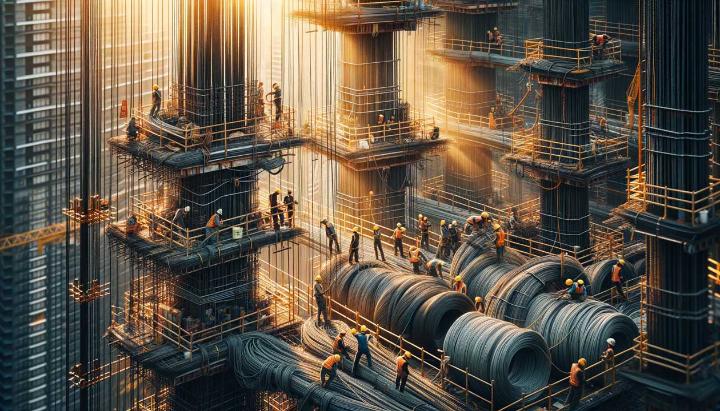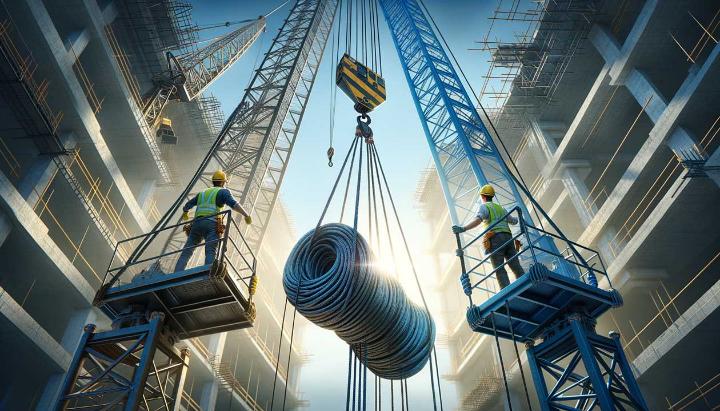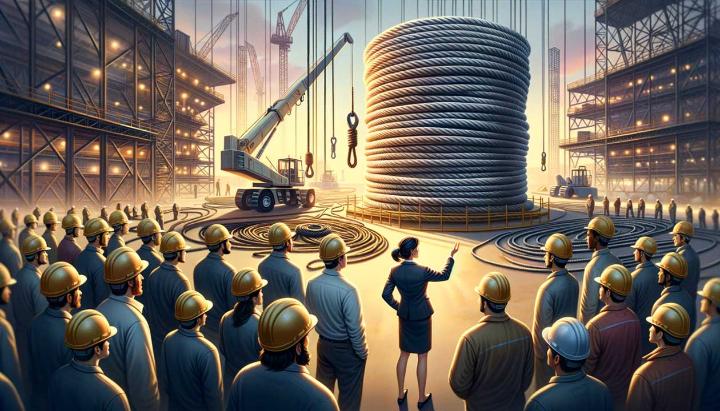Have you ever found yourself puzzled over whether to use steel cable hardware or rope hardware for your project? You're not alone. In the world of rigging and lifting, this decision can make or break your operation. As a leading manufacturer of high-quality ropes, we at iRopes have seen firsthand how crucial this choice can be.
Picture this: a construction site where a massive steel beam hangs precariously in the air. The difference between a smooth lift and a catastrophic failure often comes down to the hardware choice. That's why understanding the applications and comparisons between steel wire ropes and fibre ropes is essential for anyone in the industry.
In this post, we'll dive deep into the world of cable hardware and rope hardware, exploring their unique strengths, applications, and the factors you should consider when making your choice. Whether you're involved in off-road adventures, marine operations, or industrial lifting, this guide will help you make an informed decision that could save you time, money, and potential headaches down the line.
So, let's unravel the mystery of steel cable hardware vs rope hardware and discover which option truly is the best for your specific needs. Your next successful project might just depend on it.
Applications of Steel Cable Hardware in Various Industries
When it comes to heavy-duty applications, steel cable hardware stands out as the go-to choice for many industries. As I've observed over the years, the sheer strength and versatility of steel cables make them indispensable in a wide range of settings. Let's dive into the fascinating world of steel cable applications and explore why they're so crucial in modern engineering and construction.
Industrial Uses of Steel Wire Ropes and Cables
In the industrial sector, steel cables are the unsung heroes of many operations. I remember visiting a manufacturing plant where massive overhead cranes effortlessly lifted multi-tonne components, all thanks to the robust steel cables supporting them. These cables are the lifelines of industrial operations, quite literally bearing the weight of productivity.
- Manufacturing powerhouses: Steel cables are essential in assembly lines, material handling systems, and robotic operations, ensuring smooth and safe movement of heavy loads.
- Mining marvels: Deep underground, steel cables power excavators and draglines, extracting valuable minerals from the earth's crust.
- Oil and gas giants: Offshore rigs rely on steel cables for drilling operations and platform stability, withstanding the harsh marine environment.
Construction Applications for Steel Cable Hardware
The construction industry is perhaps where steel cables truly shine. Have you ever marvelled at a towering skyscraper or a sprawling suspension bridge? Chances are, steel cables played a pivotal role in their creation and ongoing stability.

From my experience working on construction sites, I've seen firsthand how steel cables are used in:
- Structural support: Pre-stressed concrete beams use steel cables to provide additional strength and durability to buildings and bridges.
- Temporary structures: Scaffolding and formwork often incorporate steel cables for added stability and safety during construction phases.
- Elevator systems: High-rise buildings rely on steel cables to move elevators safely and efficiently, supporting thousands of passengers daily.
The strength-to-weight ratio of steel cables makes them incredibly cost-effective for construction projects. They can bear enormous loads while remaining relatively lightweight, a crucial factor in structural engineering.
Military and Aerospace Implementations of Steel Cables
Even in the high-stakes world of defence and aerospace, steel cables play a critical role. During a recent tour of an aerospace facility, I was amazed to see how steel cables are used in aircraft arresting systems on aircraft carriers, helping jets land safely on short runways.
In the military, steel cables are used for:
- Vehicle recovery: Towing and winching operations in challenging terrains rely on the strength of steel cables.
- Perimeter security: High-tension cable fences provide robust physical barriers in sensitive areas.
- Aerospace applications: From control systems in aircraft to satellite deployment mechanisms in space, steel cables are integral to aerospace engineering.
As we've seen, the applications of steel cable hardware are vast and varied. Their unparalleled strength, durability, and versatility make them indispensable across industries. However, it's important to remember that proper installation and regular maintenance are crucial for ensuring the safety and longevity of steel cable systems. Have you ever wondered how often these cables need to be inspected or replaced? It's a fascinating aspect of industrial safety that's worth exploring further.
Advantages of Rope Hardware in Rigging and Lifting
As someone who's spent years working with various rigging systems, I can confidently say that rope hardware offers a unique set of advantages that make it indispensable in many applications. Let's dive into why rope hardware has become a go-to choice for professionals across industries.
Strength and Versatility of Wire Rope Systems
Wire rope hardware combines impressive strength with remarkable flexibility, making it suitable for a wide range of lifting and rigging tasks. I remember a project where we needed to lift heavy equipment in a tight space. The wire rope's ability to bend around obstacles while maintaining its load capacity was nothing short of amazing.
- Superior strength-to-weight ratio: Wire rope can handle heavy loads without adding significant weight to the rigging system.
- Flexibility in various environments: From construction sites to marine applications, wire rope adapts to diverse conditions.
- Customizable configurations: Wire rope systems can be easily tailored to specific lifting requirements, enhancing their versatility.

Cost-Effectiveness and Durability Compared to Chains
In my experience, the long-term value of rope hardware often outweighs its initial cost. I've seen rope systems outlast chain alternatives in harsh environments, proving their worth over time.
- Lower maintenance costs: Rope hardware typically requires less frequent replacement and servicing than chain systems.
- Improved safety features: Many rope systems incorporate built-in safety mechanisms, reducing the risk of catastrophic failures.
- Longer lifespan in challenging conditions: High-quality rope hardware can withstand exposure to elements that would quickly degrade other materials.
Have you ever considered how the choice of rigging hardware impacts your project's efficiency and safety? It's a crucial decision that can make all the difference in successful operations. For a comprehensive understanding, check out our Steel Wire Cable vs Fiber Rope Key Benefits Explained.
Remember, while rope hardware offers numerous advantages, it's essential to choose the right type for your specific needs. Always consult with rigging experts and adhere to safety guidelines to ensure optimal performance and safety in your lifting operations.
Key Factors for Choosing Between Cable and Rope Hardware
When it comes to selecting the right hardware for your project, the choice between cable and rope can be crucial. As someone who's spent years working with both materials, I can tell you that making the right decision can mean the difference between a smooth operation and a potential disaster. Let's dive into the key factors you need to consider to ensure you're making the best choice for your specific needs.
Strength and Durability Considerations
The first thing you'll want to assess is the strength and durability required for your application. I remember a project where we initially chose rope for a heavy-duty lifting operation, only to find it wasn't up to the task. We quickly learned the importance of matching the hardware to the job at hand.
- Tensile strength: Steel cable typically offers superior tensile strength, making it ideal for heavy loads and high-stress applications.
- Crushing strength: Cable hardware generally performs better under compression, which is crucial in many industrial settings.
- Flexibility: Rope hardware shines when it comes to flexibility, allowing for easier handling and storage in certain situations.
When assessing your strength requirements, always factor in a safety margin. It's better to err on the side of caution than to risk equipment failure or, worse, injury.
Application-Specific Requirements
The nature of your project will largely dictate which hardware is most suitable. I've seen countless situations where the wrong choice led to inefficiencies or even dangerous conditions.

Consider the following:
- Weight capacity: Determine the maximum load your hardware will need to support and choose accordingly.
- Diameter and length: These factors affect not only strength but also compatibility with other equipment.
- End fittings: The right terminations are crucial for safety and efficiency in your specific application.
Remember, what works perfectly in one scenario might be completely unsuitable in another. Always consult with experts or manufacturers if you're unsure about the best choice for your unique situation.
Environmental Factors to Consider
The environment in which your hardware will operate plays a significant role in its performance and longevity. I once worked on a marine project where we initially overlooked the corrosive effects of saltwater, leading to premature hardware failure. It was a costly lesson in the importance of environmental considerations.
- Corrosion resistance: Steel cable hardware often has an edge in corrosive environments, but specialised rope materials can also perform well.
- UV resistance: Some rope materials degrade quickly under sunlight, while others are specifically designed for outdoor use.
- Chemical exposure: Certain chemicals can rapidly deteriorate hardware, so it's crucial to choose materials compatible with your working environment.
When selecting your hardware, think about not just the immediate conditions but also any potential exposure over the lifespan of your project. It could save you significant time and money in the long run. For more insights, read our article on Steel Cable Wire Rope vs. Fiber Rope: Strength and Safety.
Choosing between cable and rope hardware isn't always straightforward, but by carefully considering these factors, you'll be well-equipped to make the right decision for your project. Remember, when in doubt, it's always best to consult with professionals who can provide expert guidance tailored to your specific needs.
Choosing between steel cable hardware and rope hardware depends on their unique applications, advantages, and specific project requirements. Steel cable hardware excels in heavy-duty lifting, industrial strength, and durability, making it suitable for heavy industrial, construction, and marine applications. On the other hand, rope hardware offers flexibility, ease of handling, and cost-effectiveness, ideal for applications like boating and camping. Key factors to consider include load capacity, environmental conditions, ease of use, and budget. By understanding these differences, readers can select the hardware that best meets their needs.
Need Help Choosing the Right Hardware?
If you have any questions or require further assistance in choosing the best hardware for your project, please fill in the form above. Our experts are here to help guide you through your decision-making process and ensure you get the most suitable and efficient solution for your needs.